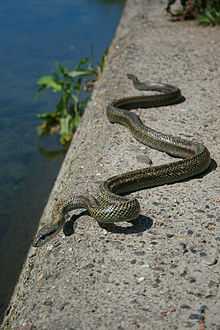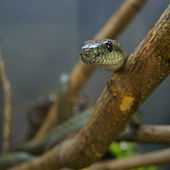Japanese rat snake
| Japanese rat snake | |
|---|---|
 | |
| Scientific classification | |
| Kingdom: | Animalia |
| Phylum: | Chordata |
| Class: | Reptilia |
| Order: | Squamata |
| Suborder: | Serpentes |
| Family: | Colubridae |
| Genus: | Elaphe |
| Species: | E. climacophora |
| Binomial name | |
| Elaphe climacophora (Boie, 1826) | |
The Japanese rat snake (Elaphe climacophora) is a medium-sized snake found throughout the Japanese archipelago (except the far South West). In Japanese it is known as the aodaishō or "blue general". It is a non-venomous snake, and a member of the colubrid family. It is hunted by eagles and raccoon dogs.
The snakes hibernate for three to four months, mate in spring and lay 7–20 eggs in early summer.
Description

Adults reach a length of between one and two meters and a girth of about five centimeters. E. climacophora is the largest Japanese snake outside of Okinawa. The color is variable, from pale yellow-green to dark blue-green.
Juveniles have a pattern of brown stripes, which may be an example of mimesis to the venomous mamushi. An albino form is known, especially around Iwakuni, where they are known and revered as "Iwakuni white snakes". The albino population was protected in 1924 as a "National Monument".
Feeding
Japanese rat snakes eat a variety of small animals: rodents, frogs or lizards. They are good at climbing and often raid bird nests. They were favoured by farmers as effective rat control, though unpopular with chicken rearers.
Hybrids
In the German reptile zoo Exotarium Oberhof Elaphe climacophora mated with Elaphe schrenckii to produce fertile hybrids. Offspring look very much like Elaphe taeniura.
References
| Wikimedia Commons has media related to Elaphe climacophora. |